- Joined
- May 7, 2023
- Messages
- 2,131
I mentioned making these drills in THIS THREAD and was asked if I would be so kind as to write up a tutorial.
Since I can find no reference of this type of grind on the internet I figured why not. I started sharpening this style of drill tip to cut into copper tubing in a factory environment. You can imagine what a standard drill would in copper tubing. This is an old school trick for drilling sheet metal and is very handy to know as unibits and the like don't always drill the hole size you actually want. I hate making sacrifices due to simple convenience, and since Im a toolmaker, I make a proper tool, its what I do.
So heres two examples of this type of point. Their both different but the same still. The larger shallower one was meant for sheet steel and the more pronounced one was made for aluminum. Both will work to varying degrees in either soft or hard materials.
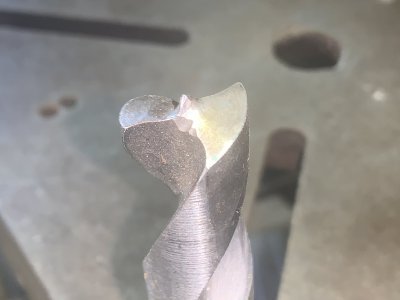
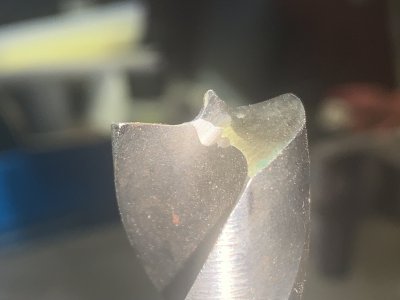
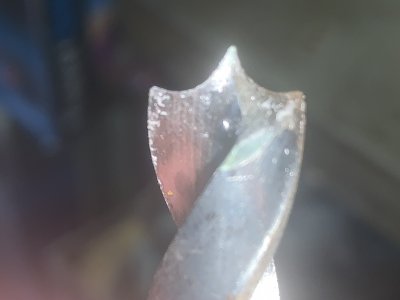
The idea with these is to have the center point contact and penetrate the material before the flutes. This stabilizes the bit and keeps it from walking while the outer tips of the flutes cut. There's also some thinning of the center point going on here. This can help penetration in harder materials, but is not always necessary. The point looks way off in this pic, but it is centered best as can be by eye.
You can see the height difference between the tip and the flutes here.
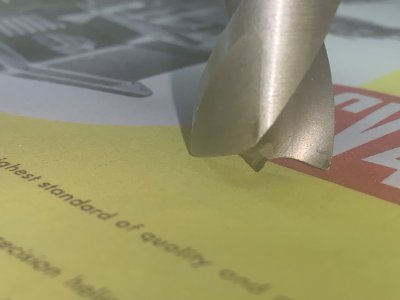
You can check if the point is centered by placing it point down on a piece of lined paper and rotating it between your fingers, looking for any obvious runout and adjusting your grind from there.
That is about a perfect "All around" point. To make this point you simply hold the bit at a shallow angle to the wheel (opposite of the angle you would normally sharpen) with the center of the drill off of the side of the wheel altogether.
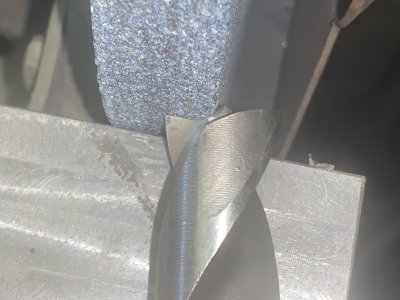
You will make a dozen wrong grinds before finally getting the hang of it, but once you do learn it it is invaluable.
I have built up a set of these that is in its own indexer out of trashed bits so I have them on hand when needed. This really only works down to maybe 3/16" bits, but that is pushing it and really depends on how true your grinding wheel is, and your eyesight.
Your best bet is start big, learn it, then try smaller bits.
Feel free to ask any questions.
Since I can find no reference of this type of grind on the internet I figured why not. I started sharpening this style of drill tip to cut into copper tubing in a factory environment. You can imagine what a standard drill would in copper tubing. This is an old school trick for drilling sheet metal and is very handy to know as unibits and the like don't always drill the hole size you actually want. I hate making sacrifices due to simple convenience, and since Im a toolmaker, I make a proper tool, its what I do.
So heres two examples of this type of point. Their both different but the same still. The larger shallower one was meant for sheet steel and the more pronounced one was made for aluminum. Both will work to varying degrees in either soft or hard materials.



The idea with these is to have the center point contact and penetrate the material before the flutes. This stabilizes the bit and keeps it from walking while the outer tips of the flutes cut. There's also some thinning of the center point going on here. This can help penetration in harder materials, but is not always necessary. The point looks way off in this pic, but it is centered best as can be by eye.
You can see the height difference between the tip and the flutes here.

You can check if the point is centered by placing it point down on a piece of lined paper and rotating it between your fingers, looking for any obvious runout and adjusting your grind from there.
That is about a perfect "All around" point. To make this point you simply hold the bit at a shallow angle to the wheel (opposite of the angle you would normally sharpen) with the center of the drill off of the side of the wheel altogether.

You will make a dozen wrong grinds before finally getting the hang of it, but once you do learn it it is invaluable.
I have built up a set of these that is in its own indexer out of trashed bits so I have them on hand when needed. This really only works down to maybe 3/16" bits, but that is pushing it and really depends on how true your grinding wheel is, and your eyesight.
Your best bet is start big, learn it, then try smaller bits.
Feel free to ask any questions.
Last edited:
